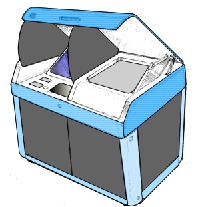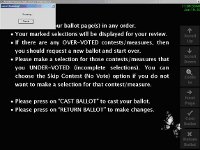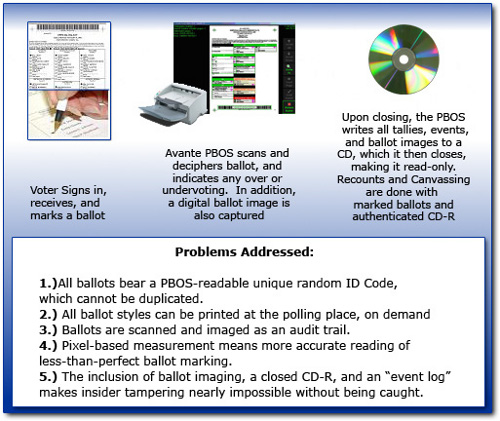AVANTE Precinct-Based Optical Scan Solution is First To Provide Verifiability and Auditability
(US Patents: 7,635,088; 7,635,087; 7,614,553; 6,892,944; 7,036,730; 7,077,313; 7,422,150; 7,431,209; 6,973,581; 7,197,167; and pending patents: 11/709,449; and others)
AVANTE pioneered and patented the use of a document imaging method for both the ballot scanning process and the electronic audit of the ballots. We use pixel-based quantitative measurements to decipher the marked ballots with unparalleled accuracy. This state-of-the-art paper balloting technology was developed by AVANTE for both central and precinct count applications.
Traditional marksense paper ballot tabulation systems suffer from poor accuracy and the ability to provide for ballot integrity throughout the overall process. Ballots can be tampered with after they have been scanned. Additional ballots can be added (stuffing the ballot box) or ballots can be discarded or replaced. Ballots can be resubmitted for scanning multiple times resulting in inaccurate results. Document imaging of ballots while they are being scanned is akin to taking a picture of the ballots. Imaging provides the needed security when using paper balloting systems.
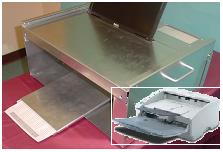
Quantitative pixel measurements of the marked ovals provide much more flexible evaluation of voters’ intent. Storing the actual pixel measurements of each mark allows easier investigation of lighter marking and erasure smeared ovals without having to rescan each ballot. By using pictures retained in storage rather than the original paper ballots, election administrators can preserve the original paper ballots for final, open, public recounting or handling of any other disputes.
PIXEL-BASED OPTICAL MARK-SENSE PAPER BALLOT VOTING SYSTEMS reduce both voters’ and system errors by presenting a true ballot image display and verification of the display resulting in unequalled accuracy analyzing voters’ intent. The OPTICAL VOTE-TRAKKER® system counts ballots efficiently and accurately.
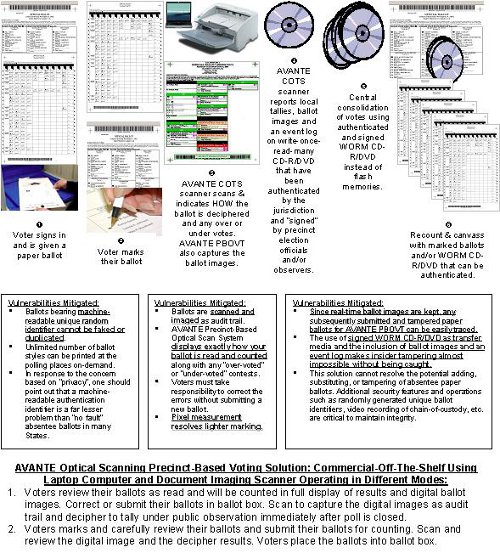
When using the VOTE-TRAKKER® Election Management Software (EMS), thousands of ballot styles can be generated for any election. There are several options for printing ballots: full ballot presentation, an abbreviated version, or a list of numbers (similar to the familiar punch card layout). With the EMS, paper ballots can be printed on demand whenever they are needed (EX: emergency or absentee ballots) using any laser printer on 20 pound paper (or other special paper as required by law). The EMS also has an option to create paper ballots with barcodes containing randomly generated unique ballot identifiers. This is in addition to the markings on the ballot that distinguishes the ballot types (or styles) and page numbers.
Using AVANTE’s Precinct-based OPTICAL VOTE-TRAKKER® ballot tabulation system is simple. Voters simply fill in the ovals on their ballots and insert their ballots into the ballot scanner. As the ballot is scanned, a picture of the ballot is taken so that each vote can be reviewed and verified on-screen confirming how it will be counted. This feature is a dramatic improvement over existing precinct-based optical scan solutons that can only alert the voters if they have any over-voted or under-voted contests but not how their ballots are being recorded.
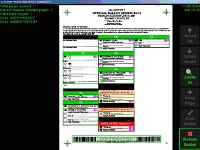
Once the voters are satisfied with their selections, they can submit/cast the ballot by pressing on the confirmation button. The deciphered result and the ballot images are recorded.
Paper ballot voting including both precinct-based and central count absentee systems have not yet received the same degree of scrutiny as have direct recording electronic (DRE) voting systems. The fact that precinct-based optical scan voting solutions are also direct recording electronic solutions has not been fully appreciated by the public and election officials alike. Precinct-based optical voting scanning uses discrete-sensor or optical mark recognition (OMR) electronics to first “read” the marked ballots submitted by the voters and then record the results directly into the flash memory of the internal computer. This is done without showing voters how the ballots are being recorded.
In fact, there are potentially other problems. Errors can result from voters marking the ballots with unintentional errors, the optical scanner reading the ballots could be incorrect, the software could make mistakes analyzing the markings, and the flash memory transfer media might be corrupted. The original paper ballots stored inside the ballot box could be fraudulently destroyed, replaced, removed, or smeared after the election.
Following is an illustration of some security vulnerabilities and accuracy issues that have not been addressed for years:
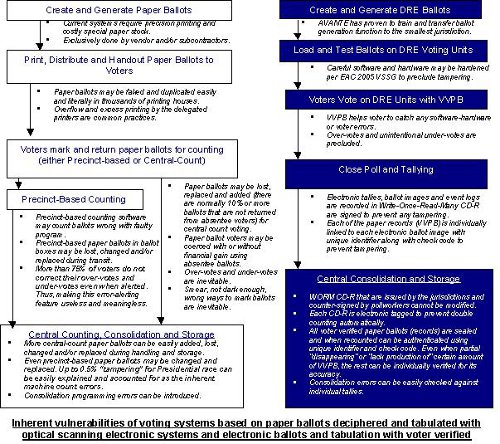
Ballot Distribution and Duplication Vulnerabilities:
- Faked ballots are easily made.
- Chain-of-custody with blank ballots is difficult.
- It is costly to print and manage hundreds and thousands of different ballot styles in polling places.
Voter Confusion and Induced Error Vulnerabilities:
- Voters are known to make 1.5% under and over votes plus other errors during Presidential races.
- Error rates increase to 3.5-20% for other lesser races.
Lack Verifiability and Transparency Vulnerabilities:
- Ballots are scanned and counted electronically with up to 0.5% inherent errors.
- Precinct-based optical scan systems based on discrete sensors only review that you have “over-voted” or “under-voted” contests but NOT how your vote is being read and counted!
- There is no assurance that your vote is counted and counted correctly.
Transfer Medium and “Black-Box” Vulnerabilities:
- All competitive systems today use read/write flash memories to transfer vote tallies.
- Flash memories can be changed without leaving any traces.
- No images of the paper ballots are shown as scanned.
- If the retained paper ballots are erased, smeared, tampered with, or substituted, no evidence can be traced.
- Tampering may not be evident when tampered tallies match the tampered paper ballots within an industry average error rate of 0.5-2.0%!
Post Tabulation to Canvassing and Auditing Vulnerabilities:
- Since no images of ballots are kept, if the flash memories are changed to match that of the erased, smeared, or substituted paper ballots, changes will not be traceable.
- With “no fault” absentee voting, excess paper ballots can be stuffed into the ballot box.
- AVANTE OPTICAL VOTE-TRAKKER® and its DRE with VVPR are also the first to provide the capability of ranked voting with “instant run-off” tabulation in accordance to the voters’ preferences.
The following is a pictorial illustration of some security issues seen in existing precinct-based optical scan solutions:

The following is an illustration and summary of the security and accuracy improvements that AVANTE has incorporated in its OPTICAL VOTE-TRAKKER® solution:


